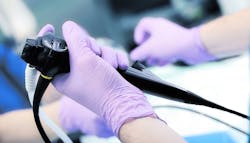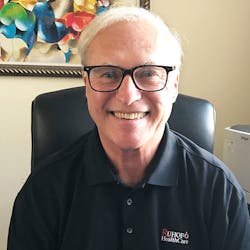Responsibility, accountability for pre-treating soiled devices finds a home
One of the hottest debates fomenting tension between the Operating Room (OR) and Sterile Processing & Distribution (SPD) showed little sign of abating until the American National Standards Institute (ANSI) and the Association for the Advancement of Medical Instrumentation (AAMI) demonstrated steadfast and swift parenting skills.
Few, if any, challenge one of the fundamental and logical tenets of reprocessing: Clean first before high-level disinfecting or sterilizing anything because if something isn’t thoroughly cleaned first it cannot be high-level disinfected or sterilized and ready for safe use on a patient.
Acknowledging and accepting one of the central tenets of reprocessing, OR and SPD professionals then move next to timing. Where does the process of reprocessing actually begin?
Until the revised ANSI/AAMI ST91:2021 standards were released by ANSI’s Endoscope Reprocessing Working Group in conjunction with AAMI’s Sterilization Standards Committee, the guidelines for reprocessing flexible and semi-rigid endoscopes left the notion of “pre-cleaning,” which ST91 re-labeled as “pre-treating,” to circular finger-pointing.
SPD professionals recognize the frustration around pre-treating soiled devices. The longer that biological/organic material remained on soiled devices post-surgery, the faster the material dried, making it harder – and more time-consuming – for SPD techs to clean. This extended the overall reprocessing time in SPD as well as the turnaround time to return devices to the OR.
“The March 2022 release of the ANSI/AAMI ST91:2021 update has made it very clear: Pre-treating needs to be carried out in the OR,” Banach told Healthcare Purchasing News.
“The use of enzymatic products should start during the pre-cleaning process at the point of use immediately following procedures,” Banach continued. “Enzymatic foams, gels and humectants designed for pre-cleaning aid in loosening soils and keeping instruments moist pending further cleaning until reprocessing begins. This discourages soils from drying and forming biofilms.”
Banach cites the direct, codified reference to remove any doubts on page 29 under the heading “7.2 Point of use treatment” and subheading “7.2.1 General considerations.
“To prevent buildup of bioburden, development of biofilms, and drying of secretions, point of use treatment is performed immediately after completion of use of the device. It is imperative that the written IFU from the endoscope, cleaning equipment, and cleaning solution manufacturers are followed. When labelled for this purpose, commercially available sponges or wipes can be used for point of use treatment. Also new automated sprayer delivery systems can add efficiency, compliance, and effectiveness.”
Although OR nurses historically have mumbled and grumbled – and in some cases resisted – about their participation in what largely has been SPD’s responsibility, ANSI/AAMI threw down the gauntlet and clarified the matter once and for all.
“Noncompliance by the OR staff is unacceptable,” Banach said. “When pathogens and micro-organisms are left on the medical device, they begin drying in minutes. It is critical to keep the device moist long enough so the decontamination processing department can do their job effectively.” Ruhof makes Prepzyme Forever Wet with Bio-Clean Technology, a multi-tiered enzymatic humectant spray for pre-treating soiled devices in the OR.
Other SPD experts quickly reinforce pre-treating soiled instruments in the OR.
“We believe that pre-treating is crucial at point of use, immediately after a procedure and prior to transport,” said David Willoughby, Vice President, Marketing & Business Development, Medtrica Solutions Ltd. “Once instruments leave the procedure room there are too many variables than can and will delay pre-treating, so by not using an enzymatic pre-cleaning agent at POU immediately after the procedure can become extremely problematic. Although pre-treating at POU can at times be perceived as an inconvenience in terms of time, it is still an important and critical first step in the cycle of instrument reprocessing. By pre-treating instruments in surgical theaters with enzymatic pre-treatment solutions, [you] will greatly reduce the occurrence of bio-contaminants adhering to instrument surfaces. And, as simple as applying a POU pre-treatment solution sounds – and is to do – unless this takes place the infection control chain can be broken causing the very outcomes these protocols were established to avoid.”
“Manufacturers and professional organizations across the healthcare spectrum agree pre-cleaning endoscopes post-procedure is an essential step in safe patient care,” Benedict indicated. “Also agreed is the timing of this step: The sooner, the better. Medical device instructions for use generally recommend pre-cleaning be performed at the end of the procedure, immediately after use, while still in the procedure room. Delays in reprocessing may require additional steps in making the device patient ready and safe. In that regard, staff are in the best position to carry out this critical step in reprocessing as they are most aware of the ‘procedural stop time.’”
Workflow should – and will – adapt, Benedict insists.
“Wiping and flushing with water or detergent can easily become part of the workflow as a documented standard of care at the bedside,” she noted. “The purpose of the wipe or flush is to remove heavy debris from the instrument to avoid drying of residual bioburden. Highlighting the rationale for this activity can increase user knowledge as to why the step is important and facilitate understanding of why pre-cleaning should be carried out by the staff who have immediate access to a device following a procedure at the point of use.”
There should be no question when and where pre-treatment should happen if you analyze procedural patterns and workflow models, according to Gregg Agoston, Vice President, Business Development, SPD Transformation Services, SpecialtyCare.
“Pre-treatment or pre-cleaning must be done in the OR,” he said. “This first step of the cleaning process helps to remove gross soil and keep the instrument moist. Due to the variable workloads in the decontamination department, instruments often have extended wait times one-two hours before the manual cleaning process begins. For flexible endoscopes, per certain IFUs, it is required that before the endoscope is detached from the video processor, that enzymatic solution or water is suctioned through the working channel. It is not feasible for the Decontamination staff to perform this process.
“From my experience, there is significant variability in OR staff performing pre-cleaning,” Agoston continued. “The key aspects are to first remove gross debris then applying enzymatic solution or take steps to prevent debris from drying on the instrument, e.g., covering with a moist lent free towel.”
Regardless of product used, the sooner the better for removing microbial load and limiting biofilm formation,” he said. “Minutes matter! Point-of-use treatment needs to occur ASAP after the procedure is complete. [A] lack of complete or effective point-of-use pre-treatment can add to the downstream workload and effectiveness – for manual cleaning, as well as high-level disinfection or sterilization. An endoscope not effectively precleaned can take that much longer to manually clean and/or may inhibit complete manual or automated cleaning/removal of bioburden and biofilm, which in turn affects the success of disinfection/sterilization.
“For certain brands of flexible endoscopes, there are steps that can only occur at the bedside – while the scope is still connected to the processor in the procedure room (e.g., the IFU directed use of the “AW Channel Cleaning Adapter”),” Whelan continued. “These steps cannot be reproduced in the processing area.”
Olympus’ Benedict remains sacrosanct.
“Neglecting pre-cleaning immediately following a patient procedure may increase the risk for infection and could increase processing time,” she said. “Allowing clinical soil to dry on the endoscope may allow biofilm to form on the device. [Pre-treating] is critical to ensure subsequent reprocessing steps, including high-level disinfection or sterilization, can be effective. When performed correctly and with knowledge as to why the process is critical, [pre-treating] is a cornerstone in high-quality safe patient care. [Pre-treating] requires minimal time to complete and provides the foundation for effective and efficient reprocessing of medical devices.”
“Failure to properly [pre-treat] instruments in the OR sets up a cascade of possible effects in the SPD,” he insisted. “Instruments that are not [pre-treated] require more time and effort by the SPD staff to clean them. This can lead to excess force being used on the item or tools that could possibly damage the instrument, e.g., wire brushes. We know that the risk of biofilm formation increases the longer the bioburden remains on the instrument. This increases the risk of ineffective cleaning, increasing the risk of [surgical site infections] to patients. It is extremely important that the OR staff perform complete [pre-treating] prior to returning products to the SPD.”
Continue reading …
AAMI redefines, revamps sterile processing practices via ST91
Who owns pre-treatment at point-of-use
Disposables/single-use devices vs. hybrids – which leads by 2035?
Strategies, tactics for high-quality endoscope reprocessing
Forget about using SUDs; what if you no longer could make them?
How might ‘right to repair’ regs impact healthcare?
How to approach patient safety gap with flexible endoscopes
About the Author
Rick Dana Barlow
Senior Editor
Rick Dana Barlow is Senior Editor for Healthcare Purchasing News, an Endeavor Business Media publication. He can be reached at [email protected].





